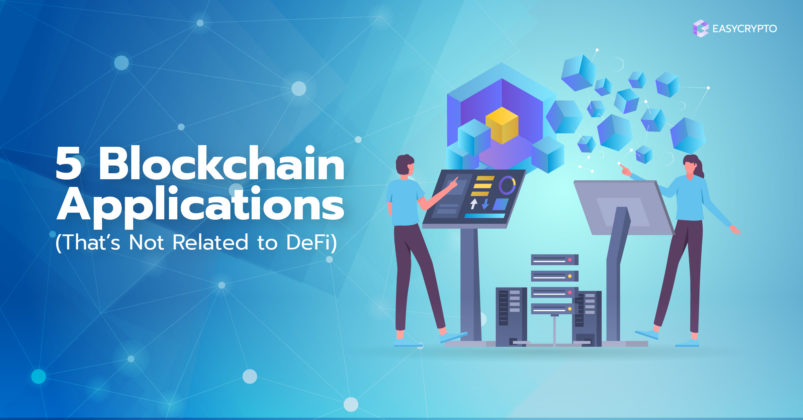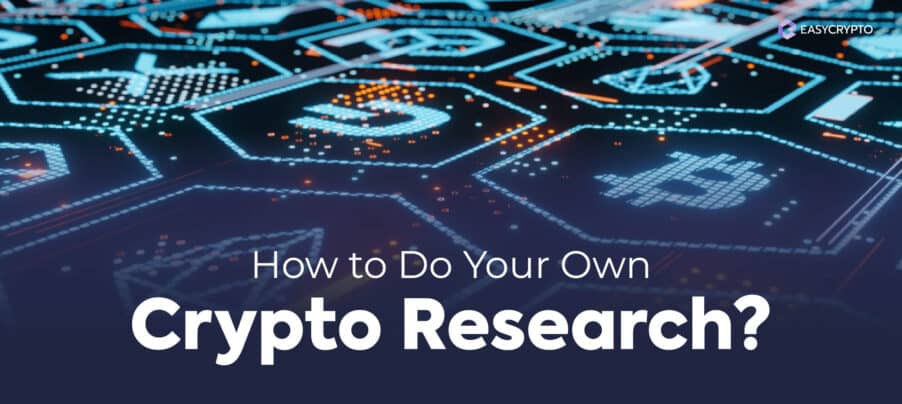5 Blockchain Applications (That’s Not Related to DeFi)
Blockchains are synonymous with decentralised finance. But did you know blockchain technology has other applications?


Blockchain is the underlying technology behind most cryptocurrencies and their applications. If you happen to be a crypto trader, chances are you’re not too concerned about the technology and its future implications.
However, if you are investing in cryptocurrencies and tokens for the long haul, learning about the technology and its applications is one of the best things you can do to manage your investment risks.
Any long-term investor will tell you to study the fundamentals of the asset beforehand, be it a stock, a bond, a property, or a commodity. The tricky part about investing in cryptocurrencies is that the methods for fundamental analysis of crypto assets are still up for debate.
However, some analysts will insist that taking a look at the applications of blockchain technology being offered is one of the best ways to get started. After all, for a crypto asset to continue to exist and appreciate in value, it needs to have utility.
This article will list only five out of hundreds of decentralised applications (or DApps) that have successfully used blockchain technology.
What common blockchain applications are out there?
Throughout much of history, cryptocurrencies have solved many problems within the financial frameworks of society. Blockchain is most commonly used for decentralised finance (DeFi) applications.
Bitcoin was the first to be utilised as a decentralised peer-to-peer payment system, where someone can send money to anyone, anywhere in the world, without having to rely on intermediaries such as a bank.
Then came Ethereum that pioneered a programmable payment system using smart contracts. This opened up a range of possible applications in the decentralised financial industry. For example, someone can borrow stablecoins with Aave, using ether as collateral, or deposit cryptocurrencies to provide liquidity and earn interest.
With Augur, a decentralised prediction market is possible, where people can bet on a future outcome of an event without relying on a centralised broker. Developers can raise funds from the decentralised crowdfunding platform Gitcoin. These are just a few examples of DeFi applications of blockchain technology.
Related: What are smart contracts, and how do they work?
AgriDigital — supply chain management systems for agriculture
Agriculture has been one of the most important industries in Australia. With increasing demands for transparency and traceability from the public, blockchain technology is incredibly useful in this sector.
Australian agricultural start-up AgriDigital offers a way for customers to be assured about product sourcing. Customers can mean end-consumers or manufacturers. For the farmers themselves, they can track where each batch of their produce is sent by the distributors.
As of 2021, over 7700 people are active users of the platform, with more than 32 million tonnes of grain transacted, which equates to 5077 million AUD transacted.
AgriDigital utilises the Ethereum network.
Related: Read our complete guide on Ethereum (ETH).
Golem Network — decentralized computing power
Machine limitations are typically one of the creative constraints experienced by any developer. However, no matter how resourceful the developer is, or how efficient the code was written, there is always room for scaling up.
The Golem Network is an open access “computing power marketplace” where developers can share their unused computing resources. Each node in the network implements the Golem Network protocol, where data can freely move across the world without fear of censorship, such as Internet access throttling.
One interesting use case of the Golem Network is that animators can rent and delegate the network’s spare computing power to cheaply render their animation projects.
The Golem Network is its own blockchain with GNT as its native token.
Decentraland — a virtual world game
Games that run on a decentralised platform will put the blockchain to the test. This is especially true for 3D virtual worlds like Decentraland, where many of the blockchain functionalities are required.
For example, a truly random number generator is required for a fair lottery reward system, such that decentralised oracles are used. Fair timing for bid and ask orders in an open market is crucial, and blockchains must be able to handle so many time-sensitive requests.
On Decentraland, users can build or generate items, NFT, and applications which can be sold or monetised. In a virtual world where users can purchase land, goods, and services within the framework of the world, the token economy (which is common in all blockchain systems) must be flawless to dampen market volatility while keeping the tokens valuable.
Decentraland runs on Ethereum and has two distinct ERC20 tokens, MANA and LAND.
Learn more about it: What is Decentraland (MANA)? The Virtual Real Estate Explained
Chainlink — a decentralised oracle network for fair data inputs
Decentralised applications can’t rely on data inputs or feeds from a single data source, even if that source provides the most robust and thorough collection of data.
A decentralised oracle network delivers data from multiple oracles, or sources, where the ‘true’ state of a certain condition (weather, market prices, etc) gets voted. The principle is simple: Nodes that provide data within an acceptable range of uncertainty will be rewarded, while nodes that attempt to deliver data outside of this range will not.
Chainlink is a blockchain that is built to meet a specific need. It exists not to outcompete other blockchains, but rather to support their smart contracts and DApps, giving the most accurate picture of the world as much as possible.
Chainlink is its own blockchain with LINK as its native cryptocurrency.
Read more: What is Chainlink (LINK), and how does it work?
Power Transition — a decentralised microgrid energy market
Energy, one of humanity’s basic needs, is centralised and is typically delivered from one direction — from centralised national power stations to homes, or from countries where power is abundant to other countries where power generation is more expensive.
To reduce the risk of power dependency on one group of energy providers, Power Transition uses blockchain technology to incentivise communities to produce electricity on a microgrid scale, and to sell excess energy locally.
The concept is similar to the Golem Network, where unused power is better utilised and distributed to others who need them more. Unlike computational power, which can be switched off, sustainable energy such as solar and wind energy is difficult to store, and must largely be utilised when there is an over-abundance of energy.
Power Transition makes a billion microtransactions a day as energy supply and demand shift dynamically from one property to another. As such, it relies on Hedera Hashgraph, which technically uses hashgraph technology that is slightly different from blockchain — both are decentralised ledger technologies (or DLTs).
Learn more about it: What is Hedera Hashgraph (HBAR)?
Can blockchain serve other industries and sectors?
While the blockchain-powered finance industry thrives, it is natural for investors to diversify their portfolio to include assets that reflect the performance of various industries and sectors.
Fortunately, blockchain technology is maturing, and enterprises are beginning to take advantage of the technology to build more secure, transparent, and fair products and services to meet the evolving needs of society.
This article will list only five out of hundreds of decentralised applications (or DApps) that have successfully used blockchain technology.
The takeaway
Decentralised financial services have long been the dominant sector that utilises DLTs such as blockchain technology. This is because DeFi applications are some of the most simple applications of a technology that allows the transfer of value in a decentralised way.
DeFi won’t be going away anytime soon. Yet, blockchain technology is also coming to other industries as well. This means you get to follow up on projects and invest in crypto tokens that are more relevant with your industry.
For example, someone working in the luxury brands industry can check out networks like VeChain, which is dominating the supply chain and auditing sectors in Asia and Europe.
No matter where you stand in the world economy, blockchain technology is gaining traction and mass adoption. So do your research and invest in the crypto technology that will bring the most value to you and your industry.
Further reading: What is decentralized finance (DeFi)?
Share to
Stay curious and informed
Your info will be handled according to our Privacy Policy.
Make sure to follow our Twitter, Instagram, and YouTube channel to stay up-to-date with Easy Crypto!
Also, don’t forget to subscribe to our monthly newsletter to have the latest crypto insights, news, and updates delivered to our inbox.
Disclaimer: Information is current as at the date of publication. This is general information only and is not intended to be advice. Crypto is volatile, carries risk and the value can go up and down. Past performance is not an indicator of future returns. Please do your own research.
Last updated September 13, 2022





